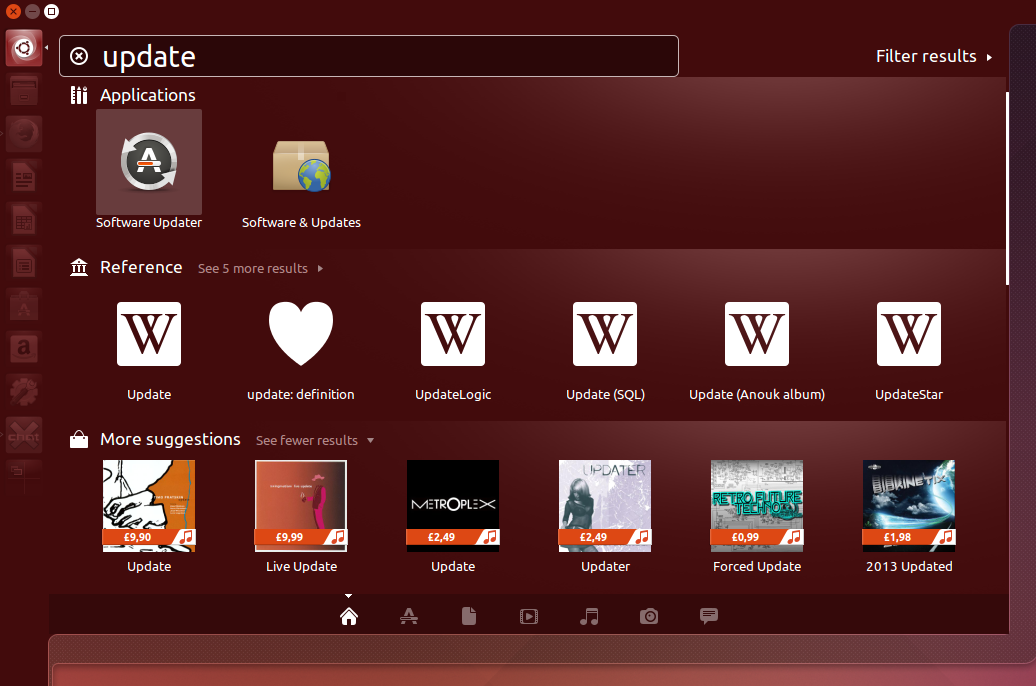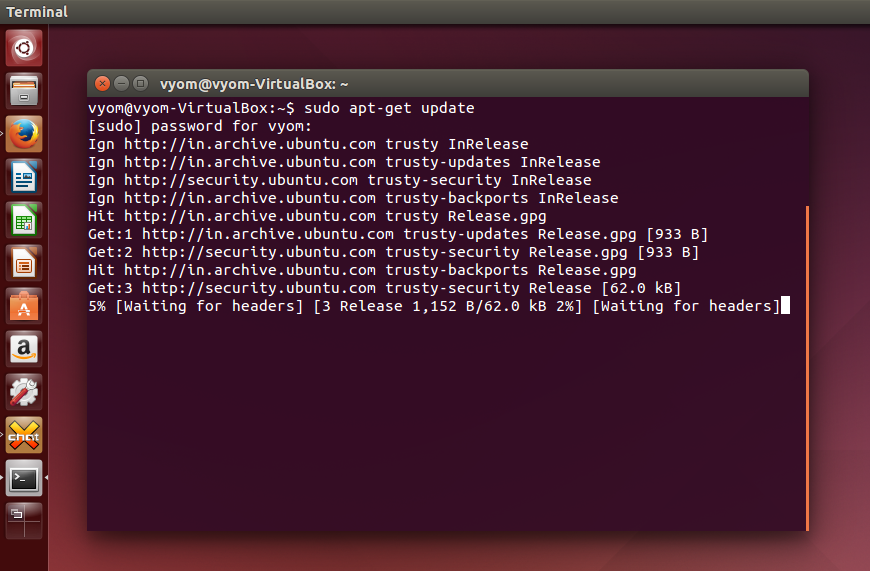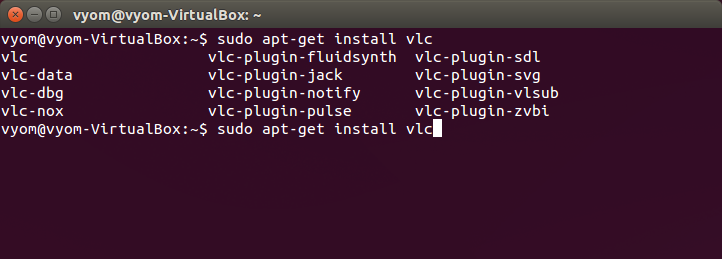In my last article I wrote about my first impressions of freshly installed Ubuntu 14.04 and shared what I knew about Unity interface which Ubuntu comes bundled with. Today I am going to update the OS and install various softwares. You can follow the steps to replicate the same on your copy of the OS or skip a few steps as per your requirements.
Installing updates is the first thing which one should do after installing a fresh copy of Ubuntu. Updates may include feature enhancement or security bugs. There are two methods to update Ubuntu. For first you can press “Dash Home” button on top of the Unity bar and type update, then select “Software Updater“.


This would check for updates and give you an option to install the updates right away. But there’s no fun in that. And I on the other hand will use more traditional way to update my OS…
Table of Contents
The Terminal!
No, I am not talking about the Tom Hanks starred 2004 movie (even though it was awesome). Shortcut to open an instance of the Terminal is Ctrl + Alt + T. Pressing the 3 combo keys will fire up this ultimate weapon of mass destruction! Or not. Well The Terminal can be mistaken as just a command line replacement of Windows, but I won’t blame you for that cause it looks deceptively simple. And therein lies the power of the terminal: simplicity. You can do almost everything from the Terminal. From the list that we made before we can see that the Terminal can be used to do following things (but not limited to):
- Updating software
- File Editor
- SSH Terminal to connect to remote VPS
- FTP Client
- IRC Client
sudo !!
Terminal is simple. You type in the commands on it and press enter to execute the command. But some commands which require admin privileges won’t execute. Sudo, which stands for Super user do is a command which you can prefix before any command you want to run in privileged mode. If the command you run requires privilege mode and you forget to use sudo, terminal will greet you with “Permission Denied” error. It is then when you can order Ubuntu to run the previous command again but this time with sudo. Example:
$ apt-get install vlc Permission Denied. $ sudo !! sudo apt-get install vlc Yes sir, installing.
In the above example, line beginning with $ is where I entered my commands. But you have to be extra careful in using sudo since as I said earlier, Terminal can be a real weapon of mass destruction if you keyed in wrong command with sudo.
Sudo is equivalent to “Run As” option in Windows.
Now that we know about the implications of sudo, lets see how to update Ubuntu using the Terminal:
Updating Ubuntu
Open up Terminal and type:
sudo apt-get update sudo apt-get dist-upgrade
You will be asked for the root password in the first command. You will need to enter the second command after first one finishes. You may need to confirm updating by pressing “Y” while the update is being installed. As you type these commands, you will see wall of texts suddenly scrolling on the screen. This is the Terminal updating Ubuntu, my friend. That’s all it took. Just a couple of quick commands. No clicks. And the system is now updated with the latest security updates. That’s the beauty of the Terminal. To know more about what each of these commands do, you can read about this in this thread.

After about few minutes (depending on the speed of your Internet connection) the updates would complete and you will be ready to install softwares that you require. Note that if you are running Ubuntu on VirtualBox, you might need to run GuestAdditions again to fix the resolution of the display.
Installing Software
Ubuntu comes with an App market called, “Ubuntu Software Center” and the icon of which is right on the Unity bar. You can open it up and search for any software you want to install from the UI. But where’s the fun doc? I am glad you asked.
We will again use The Terminal to install these softwares. I would be putting up a table now which would list all the softwares that are required to be in Ubuntu that I used to use in Windows and also be mentioning which of the softwares are factory shipped and which would I be installing.
| Softwares in Windows | Ubuntu Alternative |
| Pre-shipped | |
| Firefox | Firefox |
| Microsoft Office Picture Manager | Shotwell |
| Everything | Locate command in Terminal |
| Google Talk | EmpathyIM |
| Winamp | Rhythmbox |
| MS Office | LibreOffice or Wine |
| BullZip | PDF Printer |
| PuTTY | Terminal |
| FileZilla | Terminal |
| uTorrent | Transmission |
| To Install | |
| Nettalk | XChat |
| VLC Player | VLC |
| Steam | Steam |
| Telegram | Telegram |
| Dropbox | Dropbox |
| F.lux | F.lux |
| Microsoft Office Picture Manager | GIMP |
| Wordweb | GoldenDict |
| Netmeter | Conky comes closest |
| IDM | uGet |
| Winamp | Banshee |
| Code::Blocks | Emacs |
| MinGW (C Compiler) | GCC |
| Future Additions | |
| Teamviewer | Teamviewer |
To install any application in Ubuntu from terminal, we use following command:
sudo apt-get install package_Name
Here,
sudo : Tells Terminal to run the command in Privileged mode (admin mode),
apt-get : APT stands for Advanced Packaging Tool (APT) and is a powerful command-line tool which is used to among other things, installation and up-gradation of software packages,
install: This command tells Ubuntu to install a new software package. This command could have been replaced with “remove”, “update” and “upgrade”,
package_Name: Packages is a terminology of Linux and its just a fancy name for softwares. It is the actual name of the software which you would need to specify for that software to get installed/removed or update.
A good thing is that you don’t need to know the exact name of the package. Just enter for eg, sudo apt-get install vlc and press tab twice, and a complete list of all the package which begins with VLC will be given to you as options.

To learn more about apt-get refer this article.
Hence I used following commands to install the list of softwares that I needed to install:
sudo apt-get install xchat-gnome sudo apt-get install vlc sudo apt-get install transmission sudo apt-get install gimp sudo apt-get install goldendict sudo apt-get install conky sudo apt-get install uget sudo apt-get install banshee sudo apt-get install emacs sudo apt-get install gcc
But there are some softwares which you can’t install from apt-get command since you won’t find the required package in the repository. In our case those are: Telegram, Dropbox and F.lux. You can install these apps by following commands:
Dropbox (source):
For 32-bit OS:
cd ~ && wget -O - "https://www.dropbox.com/download?plat=lnx.x86" | tar xzf -
For 64-bit OS:
cd ~ && wget -O - "https://www.dropbox.com/download?plat=lnx.x86_64" | tar xzf -
Then following command to start the dropbox daemon:
~/.dropbox-dist/dropboxd
F.lux (source):
Installing f.lux is pretty straightforward. Just enter following 3 commands:
sudo add-apt-repository ppa:nathan-renniewaldock/flux sudo apt-get update sudo apt-get install fluxgui
First command adds information about f.lux package in the repository, second command updates the list of packages and the final command actually installs it.
Telegram:
Installing Telegram is the most tricky part. Since Telegram doesn’t provide any installable package. Hence you can follow this guide to do that.But you can install using unofficial repository of Telegram, using following commands:
sudo add-apt-repository ppa:atareao/telegram sudo apt-get update sudo apt-get install telegram
Now that we have installed all the softwares we needed we are ready to get into the nitty gritty of personalization, which I would write about in next article.
Teamviewer:
Teamviewer is not maintained in any of the apt repositories. So it have to installed via a .deb file. Here’s how to do it.
- Get the .deb file from here: http://www.teamviewer.com/en/download/linux.aspx (always get 32 bit) and save it in Downloads directory.
- Open a Terminal and write following commands.
cd Downloads sudo dpkg -i teamviewer_linux.deb
It is to note that the name teamviewer_linux.deb is the name of the .deb file you downloaded and can be anything else too.
If you face an error like following then some dependency have to be resolved:
dpkg: error processing package teamviewer (--install): dependency problems - leaving unconfigured Errors were encountered while processing: teamviewer
Run following command to resolve the dependencies and execute the sudo dpkg command again.
sudo apt-get install -f
Note that running above command the package (teamviewer) and it’s dependencies will be installed and there’s no need to run the dpkg command again.
There are ways to download a file from Terminal itself using wget but more on that in later articles.
In the end here’s the customary inclusion of the following xkcd comic:

Article last updated on 06th Jul 2017 when I started using Ubuntu 16.04.
You keep complaining that I don’t comment. Here is me commenting…… all the things wrong with this 😛
sudo stands for SuperDoer.
its sudo!! . “!!” simply copies the last command into the terminal. if you do
. then sudo!!, your new command will be sudo. That will be an error.
You messed up xkcd comic -_-. http://xkcd.com/149/ .
Just run apt-get dist-upgrade after update. No need to run apt-get upgrade and apt-get dist-upgrade. dist-upgrade is a superset of upgrade.
X-Chat is not pre-shipped. Wine is not pre-shipped. GCC is not pre-shipped. Transmission is pre-shipped.
Tap tab twice to show the autocomplete list.
APT is smart. You can list many packages to be installed in single command.
#apt-get install package1 package 2 package 3 …
Technically, installation of f.lux is via APT / repo. You just need to add the ppa into your system sources list, and then its the same as the above.
Telegram need not be that tricky to install. I’ll whip up a guide myself, if possible.
First of all, thanks for reading the article and going through the trouble of pointing out the mistakes.
About sudo!!
“It is then when you can order Ubuntu to run the previous command again but this time with sudo.”
That specify that I did mention that if you use sudo!! only previous command will run again but this time with sudo.
I didn’t mess up, I just choose to provide my own example of Tea. Anyway, added the xkcd comic.
Removed the extra command to update Ubuntu.
About XChat, GCC and Transmission I will update the article once I confirm this.
Edited to press Tab twice for auto completion.
Yes, apt can be used to update multiple packages, but I prefer not to confuse new users. If an article is aimed for beginners, only bare things should be done. I also intent to do a follow up article where advanced stuff of Terminal would be explained. The articles would grow with my understanding. 😉
Abut APT repo and adding repo, I will get back to you later, maybe in that advanced stuff of Terminal.
Nice that you created a Telegram guide. I will link your article if and when I find it to be more easy then the guide I linked above.
Again, thanks for the review of this article. Much appreciated.
Ok, just verified from a Ubuntu Live USB, about GCC, XChat and Transmision. Edited the article to reflect the change.
I installed XChat and GCC as a first thing while setting up Ubuntu on VirtualBox, hence it totally skipped my mind. Thanks. 😛
About Telegram: my guide linked above (thanks Vineet) it’s not that tricky and actually it’s not about installing Telegram, but let the system recognize it.
Man, you just need to copy/paste a few lines into a file and download an image 😉
I agree Mattia!
The guide which you wrote isn’t a bit tricky, but you know for some Windows guys if it can’t be “clickety click” to install it’s directly “tough”.
Thanks for visiting. 😉
Also, apparently, anything inside angular brackets doesn’t show up in comments. -_- .
In linux don’t beg or request to your OS!
Just order – http://i.imgur.com/eG6Tftl.jpg
😀 😀 😀
Thanks for the laugh. It’s not an actual command tho. 😆
Of course it isn’t a actual command, you can create alias for “sudo !!” by editing bashrc file.
Thanks for that info.
Look what I just found – https://github.com/nvbn/thefuck
Hey Can U teach.. How to Install kali Luniux… In Virtual Box… I have Heard kali luniux Is very very Helpful for hacking….
Kali is just like any other debian based linux. So install it normally.